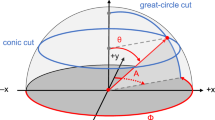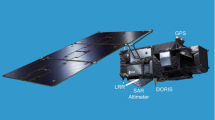Abstract
Phase center variations of the receiver and transmitter antenna constitute a remaining uncertainty in the high precision orbit determination (POD) of low Earth orbit (LEO) satellites using GPS measurements. Triggered by the adoption of absolute phase patterns in the IGS processing standards, a calibration of the Sensor Systems S67-1575-14 antenna with GFZ choke ring has been conducted that serves as POD antenna on various geodetic satellites such as CHAMP, GRACE and TerraSAR-X. Nominal phase patterns have been obtained with a robotic measurement system in a field campaign and the results were used to assess the impact of receiver antenna phase patterns on the achievable positioning accuracy. Along with this, phase center distortions in the actual spacecraft environment were characterized based on POD carrier phase residuals for the GRACE and TerraSAR-X missions. It is shown that the combined ground and in-flight calibration can improve the carrier phase modeling accuracy to a level of 4 mm which is close to the pure receiver noise. A 3.5 cm (3D rms) consistency of kinematic and reduced dynamic orbit determination solutions is achieved for TerraSAR-X, which presumably reflects the limitations of presently available GPS ephemeris products. The reduced dynamic solutions themselves match the observations of high grade satellite laser ranging stations to 1.5 cm but are potentially affected by cross-track biases at the cm-level. With respect to the GPS based relative navigation of TerraSAR-X/TanDEM-X formation, the in-flight calibration of the antenna phase patterns is considered essential for an accurate modeling of differential carrier phase measurements and a mm level baseline reconstruction.







Similar content being viewed by others
References
Bar-Sever Y, Bertiger W, Byun S, Desai S, Haines B, Hajj G (2006) Calibrating the GPS satellites transmit antenna. In: IGS Workshop 2006, Darmstadt, pp 8–11
Bettadpur S (2004) Gravity recovery and climate experiment product specification document. GRACE 327-720 (CSR-GR-03-02), Rev 4.2, August 2, 2004, Center for Space Research, The University of Texas at Austin
Dach R, Hugentobler U, Fridez P, Meindl M (2007) Bernese GPS Software Version 5.0, University of Bern
Dilssner F, Seeber G, Schmitz M, Wübbena G, Tosos G, Maeusli D (2006) Characterisation of GOCE SSTI Antennas. Zeitschrift für Geodäsie. Geoinformation Landmanagement 131:61–71 (Zfv)
Görres B, Campbell J, Siemes M, Becker M (2004) New anechoic chamber results and comparison with field and robot techniques. In: Presented at the IGS Workshop 2004, Bern, Switzerland
Jäggi A, Hugentobler U, Bock H, Beutler G (2007) Precise orbit determination for GRACE using undifferenced or doubly differenced GPS data. Adv Space Res 39:1612–1619. doi:10.1016/j.asr.2007.03.012
Kouba J (2008) A simplified yaw-attitude model for eclipsing GPS satellites. GPS Solut. doi:10.1007/s10291-008-0092-1
Luthke SB, Zelensky NP, Rowlands DD, Lemoine FG, Williams TA (2003) The 1-centimeter orbit: Jason-1 precision orbit determination using GPS, SLR, DORIS, and Altimeter data. Mar Geod 26:399–421. doi:10.1080/714044529
Haines B, Bar-Sever Y, Bertiger W, Desai S, Willis P (2004) One-centimeter orbit determination for Jason-1: new GPS based strategies. Mar Geod 27(1–2):299–318. doi:10.1080/01490410490465300
Hugentobler U, Meindl M, Beutler G, Bock H, Dach R, Jäggi A et al (2006) CODE IGS analysis center technical report 2003/04. In: Gowey k (ed) IGS technical reports 2003/04. IGS Central Bureau, JPL, CA
Kang z, Tapley B, Bettadpur S, Ries J, Nagel P, Pastor R (2006) Precise orbit determination for the GRACE mission using only GPS data. J Geod 80:322–331
Montenbruck O, Kroes R (2003) In-flight performance analysis of the CHAMP BlackJack receiver. GPS Solut 7:74–86. doi:10.1007/s10291-003-0055-5
Montenbruck O, van Helleputte T, Kroes R, Gill E (2005) Reduced dynamic orbit determination using GPS code and carrier measurements. Aerosp Sci Technol 9(3):261–271. doi:101016/jast200501003
Montenbruck O, Garcia-Fernandez M, Williams J (2006) Performance comparison of semi-codeless GPS receivers for LEO satellites. GPS Solut 10:249–261. doi:101007/s10291-006-0025-9
Pearlman MR, Degnan JJ, Bosworth JM (2002) The international laser ranging service. Adv Space Res 30(2):135–143. doi:10.1016/S0273-1177(02)00277-6
Rothacher M, Schmid R (2006) ANTEX: The Antenna Exchange Format Version 1.3, 20 September 2006
Schmid R, Rothacher M, Thaller D, Steigenberger P (2005) Absolute phase center corrections of satellite and receiver antennas—impact on global GPS solutions and estimation of azimuthal phase center variations of the satellite antenna. GPS Solut 9(4):283–293. doi:10.1007/s10291-005-0134-x
Schmid R, Steigenberger P, Gendt G, Ge M, Rothacher M (2007) generation of a consistent absolute phase center correction model for GPS receiver and satellite antennas. J Geod 81(12):781–798. doi:10.1007/s00190-007-0148-y
Sensor Systems (2003) Outline drawing L1/L2 GPS antenna passive 1575/1227 MHz (S67-1575-14); Doc. No. 0575141A #4 SA 10-31-03; Sensor Systems Inc
Wübbena G, Schmitz M, Menge F, Böder V, Seeber G (2000) Automated absolute field calibration of GPS antennas in real-time. In: Proc ION GPS-2000, pp 2514–2522
Acknowledgments
The IGOR receiver, choke rings and SLR reflector of TerraSAR-X have been contributed by the GeoForschungsZentrum (GFZ), Potsdam, to enable a high precision orbit determination of this spacecraft. Precise GPS ephemerides for use within this study have been obtained from the Center for Orbit Determination in Europe at the Astronomical Institute of the University of Bern (AIUB). Satellite laser ranging measurements of the GRACE and TerraSAR-X were provided by the International Laser Ranging Service (ILRS). The support of the above institutions is gratefully acknowledged.
Author information
Authors and Affiliations
Corresponding author
Rights and permissions
About this article
Cite this article
Montenbruck, O., Garcia-Fernandez, M., Yoon, Y. et al. Antenna phase center calibration for precise positioning of LEO satellites. GPS Solut 13, 23–34 (2009). https://doi.org/10.1007/s10291-008-0094-z
Received:
Accepted:
Published:
Issue Date:
DOI: https://doi.org/10.1007/s10291-008-0094-z




